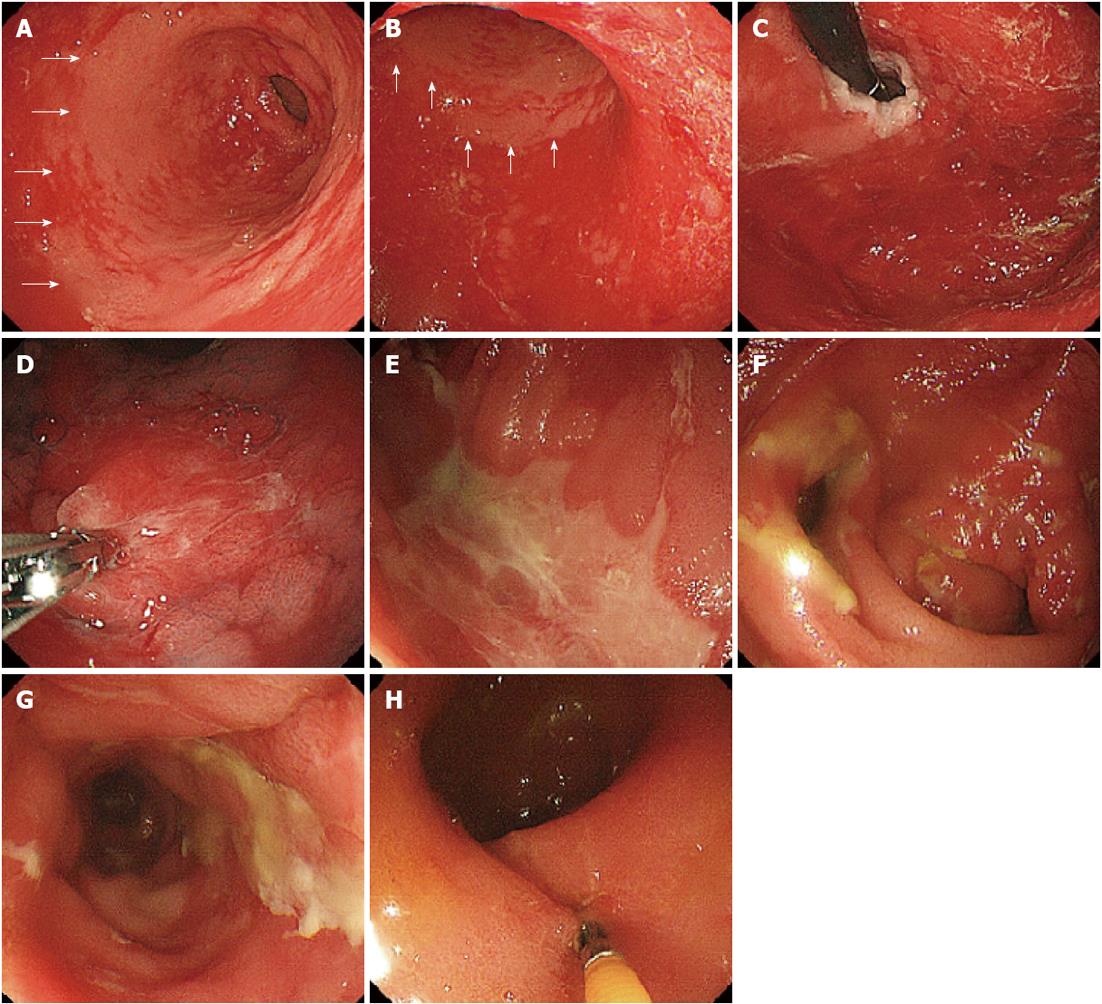Copyright
©2013 Baishideng Publishing Group Co.
World J Gastroenterol. Jan 28, 2013; 19(4): 597-603
Published online Jan 28, 2013. doi: 10.3748/wjg.v19.i4.597
Published online Jan 28, 2013. doi: 10.3748/wjg.v19.i4.597
Figure 1 Upper and lower gastrointestinal endoscopic findings.
A: The gastric mucosa in the antrum of the stomach. The antrum is the only segment exhibiting normal mucosa (arrows); B: The gastric mucosa in the lower segments of the corpus of the stomach. This mucosa demonstrates diffuse sloughing, whereas the antrum is the only segment exhibiting normal mucosa (arrows); C: The gastric mucosa in the upper segments of the corpus of the stomach; D: The greater curvature of the stomach near the center. A biopsy was taken from the edematous and sloughing mucosa of the greater curvature of the upper corpus; E: Shallow ulcer with fur at the cecal valve and cecum; F: Discrete longitudinal ulcer in the terminal ileum; G: Longitudinal ulcer with fur surrounded by the inflamed edematous mucosa of the sigmoid colon; H: Edematous mucosa of the rectum.
Figure 2 Histological findings.
Biopsy specimen from the sigmoid colon revealing a crypt with multiple apoptotic cells (arrows) with severe lymphocytes corresponding to acute gastrointestinal graft-versus-host disease (GVHD). The presence of gland apoptosis is histological evidence of acute GVHD (hematoxylin and eosin stain, × 40).
Figure 3 Upper and lower gastrointestinal endoscopic findings 70 d after the steroid therapy.
A: The gastric mucosa in the antrum of the stomach. The mucosa is normal but somewhat edematous; B: The gastric mucosa in the lower segments of the corpus of the stomach, which has improved even though the rough gastric mucosal patterns and edematous changes remained; C: The gastric mucosa in the upper segments of the corpus of the stomach, which has also improved; D: The greater curvature of the stomach near the center. The endoscopic clipping has remained; E: Sigmoidoscopy revealing multiple discrete ulcers in the sigmoid colon; F: Disappearance of the visible vascular pattern in the sigmoid colon.
Figure 4 Immunostaining of the biopsy specimen.
Immunohistochemically stained biopsy specimen from an ulcer of the sigmoid colon showing multiple cytomegalovirus-positive cells (arrows) (immunohistochemical stain, × 40).
Figure 5 Upper and lower gastrointestinal endoscopic findings 162 d after the steroid and anti-cytomegalovirus therapies.
A: The gastric mucosa in the antrum of the stomach; B: The gastric mucosa in the lower segments of the corpus of the stomach; C: The gastric mucosa in the upper segments of the corpus of the stomach; D: The greater curvature of the stomach near the center. The endoscopic clipping has remained, and nearly the entire mucosa of the stomach has improved to a normal state; E: Normal mucosa in the cecal valve and cecum; F: Normal mucosa in the terminal ileum; G: Marked improvement of the inflammation of the colonic mucosa, and healed ulcers in the sigmoid colon; H: The vascular patterns are now visible, indicating that the normal mucosa has returned in the rectum.
- Citation: Okubo H, Nagata N, Uemura N. Fulminant gastrointestinal graft-versus-host disease concomitant with cytomegalovirus infection: Case report and literature review. World J Gastroenterol 2013; 19(4): 597-603
- URL: https://www.wjgnet.com/1007-9327/full/v19/i4/597.htm
- DOI: https://dx.doi.org/10.3748/wjg.v19.i4.597













